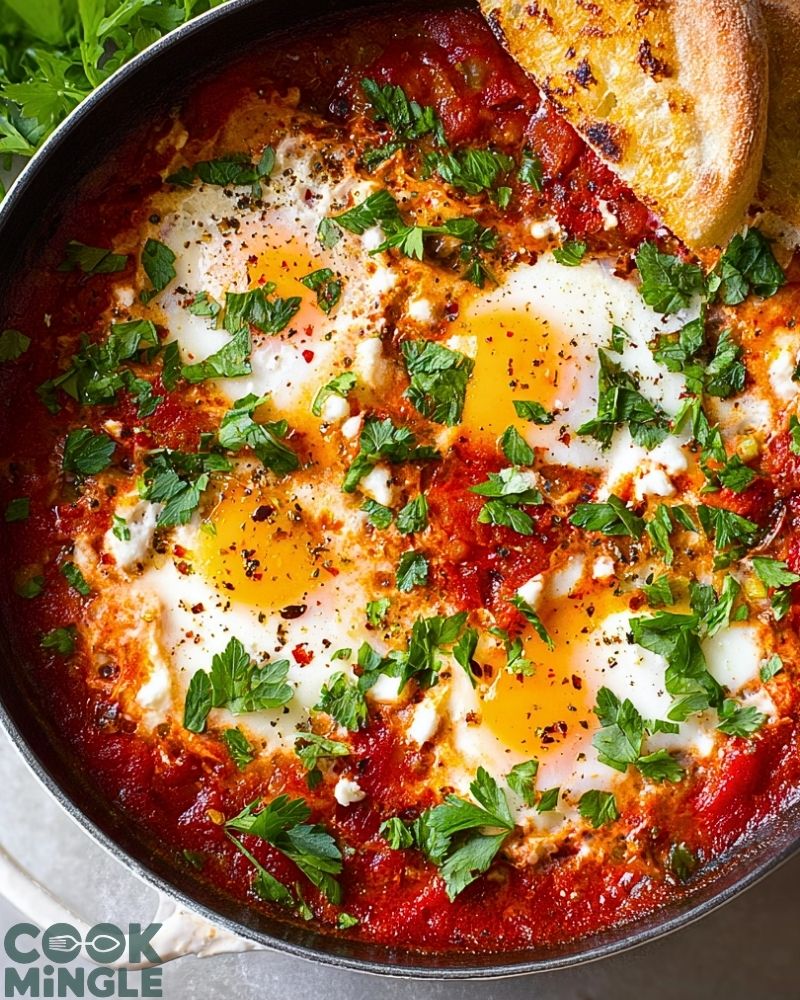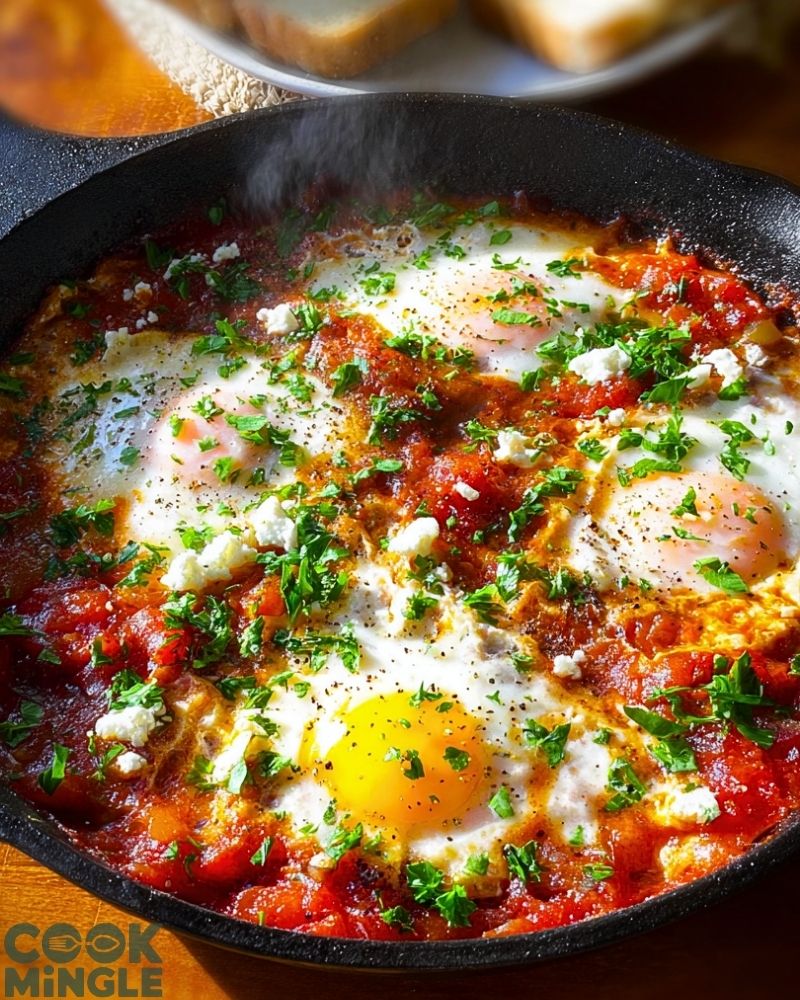Shakshuka is a dish that wraps you in warmth and comfort from the very first bite. Originating from North Africa and wildly popular across the Middle East, this hearty, one-skillet meal features poached eggs nestled in a rich, spiced tomato and pepper sauce. It’s the kind of breakfast—or brunch or dinner—that tastes far more complex than the effort it takes to prepare. Bursting with bold flavors from cumin, paprika, and garlic, it’s both a rustic and deeply satisfying dish.

What truly sets shakshuka apart is how customizable it is. Whether you’re cooking for one or feeding a crowd, it scales beautifully. Want it spicy? Add chili. Craving extra creaminess? Crumble in some feta. It welcomes crusty bread with open arms, perfect for scooping up every drop of sauce and yolk. Served hot straight from the skillet, it makes any table feel like a celebration.
Why You’ll Love This Shakshuka Recipe
- Simple yet impressive: It comes together in one pan with everyday ingredients but looks and tastes like something special.
- Versatile: Serve it for breakfast, lunch, or dinner; dress it up with extras like feta, spinach, or olives.
- Nutritious & satisfying: Packed with protein from the eggs and rich in antioxidants from the tomatoes and peppers.
- Naturally vegetarian & gluten-free: A wholesome option for many diets.
- Customizable heat and seasoning: From mild to fiery, you control the spice level.
Preparation Phase & Tools to Use (Essential Tools and Equipment, and Their Importance)
Making the best shakshuka doesn’t require a fancy kitchen setup—just a few reliable tools to help you achieve perfection. Here’s what you’ll need and why each one matters:
- Heavy-Bottomed Skillet or Cast Iron Pan: This is the heart of shakshuka. A heavy skillet (preferably cast iron) ensures even heat distribution, which is crucial for gently cooking the eggs without scorching the tomato sauce.
- Lid for the Pan: A snug-fitting lid allows the eggs to poach evenly in steam without drying out or becoming rubbery.
- Wooden Spoon or Silicone Spatula: Helps stir the sauce without scratching your pan and gives you good control over consistency.
- Sharp Knife and Cutting Board: Essential for prepping onions, garlic, and bell peppers quickly and safely.
- Measuring Spoons: To get your spices just right. A slight variation in cumin or paprika can change the entire flavor profile.
These basic kitchen tools make the preparation easy and mess-free, letting you focus on layering flavor and cooking with confidence.
Preparation Tips
- Use ripe, flavorful tomatoes: If you’re using fresh tomatoes instead of canned, make sure they’re juicy and well-ripened. Alternatively, quality canned crushed tomatoes save time and still deliver rich flavor.
- Slice vegetables evenly: This ensures that your onions and peppers cook at the same rate, avoiding raw or over-soft bites.
- Simmer the sauce well before adding eggs: Allowing the tomato base to cook down slightly deepens the flavor and thickens it enough to cradle the eggs.
- Make small wells for the eggs: This helps keep the yolks intact and nestled while they poach.
- Don’t overcook the eggs: The yolks should be runny. Cover the skillet and check them after a few minutes to avoid overcooking.
- Toast your bread ahead of time: Shakshuka is always better with something to mop it up—have your bread warm and ready!
Ingredients for This Shakshuka Recipe
Creating an unforgettable shakshuka starts with vibrant, fresh ingredients. Here’s everything you’ll need to bring this savory dish to life:
- 2 tablespoons olive oil – For sautéing the base vegetables and building flavor.
- 1 medium yellow onion, finely chopped – Adds natural sweetness and depth.
- 1 red bell pepper, chopped – Brings color, crunch, and subtle sweetness.
- 3 garlic cloves, minced – For aromatic richness.
- 1 teaspoon ground cumin – Earthy and warm, a classic shakshuka spice.
- 1 teaspoon smoked paprika – Adds a smoky undertone that enhances the tomatoes.
- ¼ teaspoon chili flakes (optional) – For a gentle kick of heat.
- 1 can (28 oz) crushed tomatoes – The base of your sauce; choose high-quality for best flavor.
- Salt and freshly ground black pepper – To taste, essential for seasoning.
- 4–6 large eggs – Gently poached in the sauce for the signature shakshuka touch.
- ¼ cup crumbled feta cheese (optional) – Adds tang and creaminess.
- Fresh parsley or cilantro, chopped – For a bright, herbaceous finish.
Optional add-ins:
- A handful of baby spinach or kale
- Sliced olives or chopped sun-dried tomatoes
- A pinch of sugar if your tomatoes taste too acidic
This ingredient list delivers a perfect balance of sweet, savory, and spicy notes—all while staying true to shakshuka’s bold, comforting essence.

Step 1: Sauté the Base
Heat the olive oil in a large, heavy-bottomed skillet over medium heat. Once hot, add the chopped onion and bell pepper. Cook for about 5–7 minutes, stirring occasionally, until the vegetables are soft and beginning to caramelize slightly. Add the minced garlic and cook for another 1 minute until fragrant.
Step 2: Add the Spices
Sprinkle in the cumin, smoked paprika, and chili flakes (if using). Stir well so the vegetables are fully coated and the spices are toasted, releasing their aroma—this should take about 30 seconds.
Step 3: Build the Sauce
Pour in the crushed tomatoes and stir everything together. Season with salt and freshly ground black pepper to taste. Reduce the heat to low and let the sauce simmer for 10–15 minutes, stirring occasionally, until it thickens slightly and the flavors meld beautifully.
Step 4: Make the Egg Wells
Use the back of a spoon to make 4–6 small wells in the tomato sauce. Carefully crack an egg into each well, making sure to keep the yolks intact.
Step 5: Poach the Eggs
Cover the skillet with a lid and let the eggs cook for about 5–7 minutes, or until the whites are set but the yolks are still runny. For firmer yolks, cook an extra 1–2 minutes. Keep an eye on them!
Step 6: Garnish and Serve
Remove the skillet from the heat. Sprinkle crumbled feta over the top, then finish with a generous handful of chopped parsley or cilantro. Serve straight from the pan with crusty bread, pita, or flatbread.
Notes
- Fresh vs. Canned Tomatoes: Both work wonderfully, but canned crushed tomatoes save time and offer a consistent texture year-round. If using fresh, opt for ripe plum tomatoes and peel them first for a smoother sauce.
- Spice Flexibility: Customize the heat with more or less chili flakes. You can also add harissa or a pinch of cayenne for extra depth.
- Add-ins: A handful of baby spinach stirred in before the eggs adds extra nutrition without changing the flavor too much.
- Egg Count: You can adjust the number of eggs based on your skillet size or how many people you’re feeding. The sauce base can easily hold 4 to 6 eggs.
- Cheese Variations: Feta is traditional, but goat cheese or labneh can be delicious alternatives.
- Make it ahead: The tomato sauce can be made a day in advance and reheated when ready to add the eggs.
Watch Out for These Mistakes While Cooking
- Overcooking the eggs: It’s easy to go from runny yolks to chalky centers. Keep the lid on, but check frequently once you see the whites beginning to set.
- Sauce too thin: If your sauce hasn’t reduced enough before adding the eggs, they may sink or not cook evenly. Simmer until thick and slightly jammy.
- Under-seasoning: Tomatoes need salt to bring out their flavor—don’t be shy, but taste as you go.
- High heat: Cooking over high heat can cause the sauce to scorch or eggs to cook unevenly. Medium to low heat is your friend here.
- Skipping the lid: Poaching eggs without a lid takes much longer and leads to uneven whites. Always cover the skillet.
- Crowding the pan: Adding too many eggs can prevent them from cooking evenly and overcrowd the sauce. Use a larger skillet or reduce the egg count.
- Adding eggs too early: Wait until your sauce is ready before adding eggs—doing it too early means watery flavor and uneven poaching.
What to Serve With Shakshuka?
Shakshuka is a complete meal on its own, but the right accompaniments can elevate it to something even more special. From breads to fresh sides, here are some delicious pairings to complement its bold, savory flavors.
8 Recommendations
- Crusty Bread or Pita
Essential for scooping up the sauce and yolks—sourdough, baguette, or warm pita are all perfect choices. - Labneh or Greek Yogurt
A cool, creamy dollop of labneh or tangy yogurt adds a refreshing contrast to the warm spices. - Israeli Salad
A light mix of chopped cucumbers, tomatoes, parsley, and lemon juice helps balance the richness of the shakshuka. - Olives and Pickles
A small plate of briny olives or tangy pickled vegetables adds texture and brightness. - Avocado Slices
Creamy avocado offers a mellow flavor and smooth texture that pairs beautifully with the spicy tomato sauce. - Falafel or Chickpea Patties
Serve on the side for a protein boost and a Middle Eastern twist. - Tahini Drizzle
Drizzle over the top for a nutty, earthy finish that adds a whole new dimension. - Fresh Herbs and Lemon Wedges
A squeeze of lemon and a sprinkle of chopped herbs can instantly lift the entire dish.
Whether you’re setting up a brunch table or a cozy dinner, these sides round out your shakshuka and bring out its vibrant, comforting character.
Storage Instructions
Shakshuka is best enjoyed fresh, but if you have leftovers, they can still be delicious with the right storage:
- Refrigeration: Let the shakshuka cool completely, then transfer to an airtight container. Store in the refrigerator for up to 3 days.
- Reheating: Warm the shakshuka gently in a skillet over medium-low heat. If the eggs have already been poached, try to avoid overcooking them during reheating. Alternatively, you can remove the eggs, reheat the sauce, then add fresh eggs to poach.
- Freezing: You can freeze the sauce only (without eggs) for up to 2 months. Thaw in the refrigerator overnight, then reheat and add eggs when ready to serve.
Estimated Nutrition
Per serving (based on 4 servings with 6 eggs total and optional feta included):
- Calories: 270
- Protein: 13g
- Fat: 17g
- Saturated Fat: 5g
- Carbohydrates: 18g
- Fiber: 4g
- Sugars: 9g
- Cholesterol: 190mg
- Sodium: 580mg
Note: Nutrition values can vary based on ingredient brands and portion sizes. Adjustments like omitting cheese or reducing oil can lower fat and calorie content.
Frequently Asked Questions
1. Can I use fresh tomatoes instead of canned?
Yes! Use about 6–7 ripe plum tomatoes. Peel and chop them before cooking. You may need to cook them a bit longer to get the same thick consistency as canned.
2. Can I make shakshuka vegan?
Absolutely. Just skip the eggs and cheese. You can add chickpeas or tofu for protein. Let the tomato sauce shine as the centerpiece.
3. How do I know when the eggs are perfectly cooked?
Watch for the whites to be just set and the yolks to still have a slight wobble. Covering the pan helps the eggs steam evenly. Check around 5 minutes in.
4. What’s the best bread to serve with shakshuka?
Any crusty bread works well—sourdough, baguette, or pita are great choices. You want something sturdy to scoop up that saucy goodness.
5. Can I make shakshuka spicy?
Definitely. Add more chili flakes, fresh chopped chili, or a spoonful of harissa paste to kick up the heat.
6. How many people does this recipe serve?
It comfortably serves 4 people, especially with bread or sides. You can stretch it to 6 smaller portions with more eggs and accompaniments.
7. Can I prepare the sauce ahead of time?
Yes. The tomato base can be made a day ahead and refrigerated. Just reheat, then add the eggs when you’re ready to serve.
8. Is shakshuka only for breakfast?
Not at all! It’s enjoyed any time of day—brunch, lunch, or dinner. It’s hearty, flavorful, and works whenever you’re hungry.
Conclusion
Shakshuka is more than just a dish—it’s a celebration of warmth, comfort, and bold flavor in every spoonful. With simple ingredients and a one-pan method, you get a meal that’s as visually striking as it is satisfying. Whether you’re new to Middle Eastern cooking or a seasoned home chef, shakshuka is an easy way to bring global flavor to your table.
Ready to enjoy golden eggs swimming in rich, spiced tomato sauce? Grab your skillet and start cooking—it might just become your new favorite go-to.

The Best Shakshuka Recipe Ever
- Total Time: 35 minutes
- Yield: 4 servings
Description
Shakshuka is a bold and comforting one-skillet dish of poached eggs in a spicy, aromatic tomato and pepper sauce. With North African and Middle Eastern roots, it delivers hearty flavor, perfect for breakfast, brunch, or dinner. This version is simple to make and endlessly customizable.
Ingredients
- 2 tablespoons olive oil
- 1 medium yellow onion, chopped
- 1 red bell pepper, chopped
- 3 garlic cloves, minced
- 1 teaspoon ground cumin
- 1 teaspoon smoked paprika
- 1/4 teaspoon chili flakes (optional)
- 1 can (28 oz) crushed tomatoes
- Salt and black pepper to taste
- 4–6 large eggs
- 1/4 cup crumbled feta cheese (optional)
- Fresh parsley or cilantro, chopped
Optional Add-ins:
- Baby spinach or kale
- Sliced olives or sun-dried tomatoes
- Pinch of sugar (if tomatoes are acidic)
Instructions
- Heat olive oil in a skillet over medium heat. Sauté onion and bell pepper until soft (5–7 minutes).
- Add garlic and cook for 1 minute. Stir in cumin, paprika, and chili flakes.
- Pour in crushed tomatoes. Season with salt and pepper. Simmer 10–15 minutes.
- Make 4–6 wells in the sauce. Crack an egg into each well.
- Cover and cook until whites are set and yolks are still soft, 5–7 minutes.
- Sprinkle with feta and herbs. Serve hot with bread.
- Prep Time: 10 minutes
- Cook Time: 25 minutes

